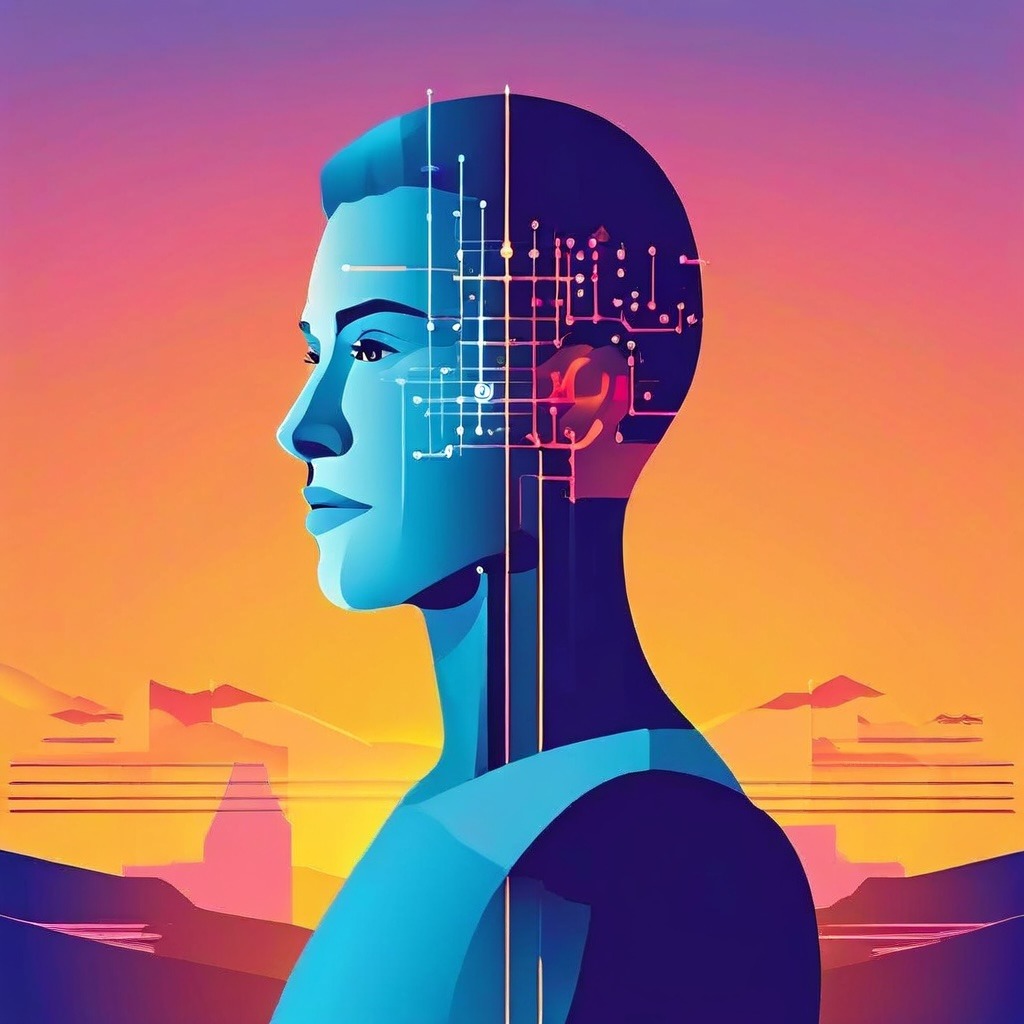Artificial General Intelligence (AGI), a concept once relegated to science fiction, is rapidly emerging as a frontier of technological exploration. While still in its nascent stages, AGI holds the potential to revolutionize numerous facets of our lives, impacting industries like education and healthcare in profound ways. But before we delve into its potential applications, it’s crucial to understand the foundation, current state, and future predictions surrounding this fascinating technology.
Unveiling the Enigma: Laying the Groundwork for AGI
Unlike the narrowly focused “narrow AI” we encounter daily in voice assistants and recommendation engines, AGI aspires to something far more ambitious: replicating or surpassing human-level intelligence. This ambitious goal necessitates the ability to learn, reason, adapt, and solve problems across diverse domains, mirroring the versatility of the human mind.
The foundation of AGI rests upon several key pillars:
- Machine Learning: This branch of AI allows systems to learn and improve their performance from data, without explicit programming for every scenario. Deep learning, a subset of machine learning, utilizes artificial neural networks inspired by the human brain to process and analyze complex information.
- Natural Language Processing (NLP): Enables machines to comprehend and generate human language, a critical step towards achieving the kind of communication and understanding necessary for AGI.
- Reasoning and Problem-Solving: This entails developing algorithms capable of logical deduction, critical thinking, and drawing conclusions from incomplete information, mirroring human cognitive abilities.
However, the path to AGI is fraught with challenges. One major hurdle lies in replicating human-level consciousness and self-awareness. Another lies in bridging the gap between the computational power of machines and the energy-efficient biological computation of the brain. Ethical considerations also loom large, demanding thorough discussions about the potential risks and societal implications of superintelligent machines.
The Current Landscape: Where Does AGI Stand?
As of now, AGI remains a work in progress. Current AI systems, while advanced, are still categorized as narrow AI. However, there are significant strides:
- Deep Learning: Deep learning models have shown exceptional performance in complex tasks, hinting at the potential for AGI.
- Cross-Domain Learning: Some AI systems can learn and apply knowledge across different fields, a stepping stone towards AGI.
- Human-Like Interaction: AI systems like GPT-3 demonstrate impressive natural language understanding and generation, an essential aspect of AGI.
While we haven’t yet reached the pinnacle of AGI, significant progress has been made in recent years. Deep learning algorithms have achieved remarkable feats, from defeating top Go players to composing realistic music. Advancements in fields like robotics and NLP are further blurring the lines between human and machine capabilities. However, it’s crucial to remember that these advancements represent stepping stones on the path to AGI, not the final destination.
Furthermore, it’s essential to distinguish between AGI and “strong AI” or “conscious AI” terms often used interchangeably. While AGI aims for human-level intelligence in a specific sense, the concepts of consciousness and sentience remain distinct and highly debated within the scientific community.
A Glimpse into the Future: Predicting the Trajectory of AGI
Predicting the exact timeline for AGI’s arrival is notoriously difficult. Some experts believe it’s imminent, while others maintain it could be decades before we witness true AGI. Regardless of the specific timeframe, the potential impact of AGI across various sectors is undeniable. Let’s explore how AGI could revolutionize two crucial pillars of human society: education and healthcare.
Education: Tailored Learning for Every Mind
Personalized Learning
AGI has the potential to personalize education to an unprecedented degree. Imagine a system that diagnoses individual learning styles, identifies knowledge gaps, and curates customized learning pathways for each student. This could significantly enhance learning outcomes, cater to diverse needs, and bridge the equity gap in education.
Furthermore, AGI-powered tutors could offer personalized guidance and feedback, providing students with immediate support and addressing their unique challenges. Additionally, AGI could revolutionize language learning by creating immersive and interactive environments that simulate real-world interactions and accelerate language acquisition.
- Adaptive Learning Platforms: AGI-powered platforms can adjust curriculum and learning materials based on individual student needs and learning styles. By analyzing student performance data, the system can identify gaps in knowledge, recommend targeted learning resources, and adjust the difficulty level of tasks to optimize learning outcomes.
- Micro-credentialing and Personalized Pathways: AGI can identify individual skill gaps and recommend relevant micro-credentials or learning pathways that cater to specific career aspirations, fostering a more personalized and outcome-oriented approach to education.
- Real-time Feedback and Intervention: AGI can analyze student performance data in real-time, providing immediate feedback and identifying areas where additional support or intervention might be necessary. This allows educators to address student needs proactively and personalize their teaching strategies.
- Dynamic Course Materials and Adaptive Learning Objects: AGI can continuously adapt and update curriculum materials based on real-time student needs and feedback. This ensures that students are engaging with the most relevant and up-to-date information, tailored to their specific learning journey.
- Automated Content Curation and Personalization: AGI can personalize learning resources by filtering and recommending content based on individual learning styles, interests, and academic goals. This allows students to access relevant and engaging materials that cater to their unique needs and preferences.
- Automated Grading and Feedback Systems: AGI-powered systems can analyze student work for accuracy, comprehension, and adherence to specific criteria, providing feedback with varying levels of detail and guidance based on the individual student’s performance.
Access to Quality Education
AGI-powered platforms could offer high-quality education resources, breaking geographical and socio-economic barriers. This democratization of education could bridge the global education gap.
Intelligent Language Learning:
- Immersive and Interactive Learning Environments: AGI can create personalized and interactive language learning experiences that simulate real-world scenarios, such as conversations with native speakers or virtual travel experiences. This can significantly enhance language acquisition by improving fluency, comprehension, and cultural understanding.
- Adaptive Grammar and Pronunciation Correction: AGI-powered systems can analyze spoken and written language in real-time, providing personalized feedback on grammar mistakes, pronunciation errors, and appropriate word choice. This can offer students immediate corrective feedback and accelerate their language learning journey.
- Tailored Learning Content and Exercises: AGI can personalize learning materials and exercises based on individual language proficiency levels, learning styles, and specific areas of need. This ensures that students are exposed to appropriate content that caters to their individual progress and preferences.
Enhancing Teacher Capabilities
AGI can assist teachers by providing insights into student performance, suggesting teaching strategies, and automating administrative tasks, allowing teachers to focus more on teaching.
Intelligent Tutoring Systems and Personalized Support:
- Automated Administrative Tasks: AGI can handle administrative tasks such as grading, attendance tracking, and scheduling, freeing educators to focus more on teaching and student engagement.
- Insights and Analytics for Teachers: By analyzing student performance data, AGI can provide teachers with insights into the effectiveness of their teaching methods and suggest improvements or interventions.
- Professional Development: AGI can identify skill gaps in educators and recommend personalized professional development resources or training modules.
- 24/7 Virtual Tutors: AGI-powered virtual tutors can provide personalized support and guidance to students outside of traditional classroom settings. This allows students to access additional support on specific topics, clarify doubts at their own pace, and reinforce their understanding beyond classroom hours.
- Individualized Feedback and Progress Tracking: AGI-powered systems can analyze student work, offering personalized feedback and suggestions for improvement. Additionally, these systems can track student progress over time, allowing educators and students to monitor learning trajectories and adjust strategies as needed.
- Identifying At-Risk Students and Targeted Support: AGI can analyze student performance data to identify students who might be at risk of falling behind or struggling with specific concepts. This allows early intervention and personalized support, preventing academic difficulties and fostering a more inclusive learning environment.
Healthcare: Personalized Medicine and Precision Diagnosis
The potential of AGI in healthcare is equally promising. Imagine a future where AI-powered systems analyze vast amounts of medical data to predict disease outbreaks, identify at-risk individuals, and recommend preventative measures. Additionally, AGI could revolutionize medical diagnosis by analyzing complex medical images and identifying subtle anomalies that might elude human detection.
Furthermore, AGI could pave the way for personalized medicine, tailoring treatment plans to individual patients based on their unique genetic makeup, medical history, and response to various therapies. This could lead to more effective and targeted treatments, improving patient outcomes and reducing side effects.
Beyond the general overview, let’s delve deeper into specific applications of AGI in the healthcare sector:
1. Personalized Medicine and Precision Diagnosis:
- Genomic Analysis: AGI can analyze vast amounts of genomic data, identifying genetic markers associated with specific diseases and tailoring treatment plans based on an individual’s unique genetic makeup.
- Real-time Disease Monitoring: Continuous monitoring and analysis of real-time data from wearable devices and implantable sensors could enable early detection of medical conditions and trigger preventive measures.
- Virtual Assistants for Chronic Disease Management: AI-powered virtual assistants can provide personalized coaching and support to patients managing chronic conditions, promoting medication adherence, healthy lifestyle choices, and self-management skills.
2. Drug Discovery and Development:
- Accelerating Drug Discovery: AGI can analyze vast datasets of information from previous research, clinical trials, and real-world data to identify potential drug targets, optimize drug design, and predict the effectiveness and safety of new medications.
- Repurposing Existing Drugs: AGI can analyze existing drugs and identify new therapeutic applications for different diseases, potentially saving time and resources in the drug development process.
- Personalized Dosage Optimization: AGI-powered systems can analyze individual patient data and recommend personalized medication dosages, taking into account factors like genetic variations, existing medications, and potential drug interactions.
3. Robotic Surgery and Assisted Procedures:
- Enhanced Surgical Precision: AGI-powered robots can assist surgeons during complex procedures, providing greater precision and minimizing human error.
- Minimally Invasive Interventions: AGI-equipped robotic systems can enable minimally invasive surgical procedures, leading to faster recovery times and reduced patient discomfort.
- Remote Surgery and Telemedicine: AGI-powered surgical robots could facilitate remote surgeries, enabling specialist surgeons to perform complex procedures on patients located in remote regions.
4. Mental Health Support and Therapy:
- AI-powered Chatbots for Mental Wellness: Chatbots powered by AGI can provide initial screening for mental health issues, offer confidential support and resources, and guide individuals towards appropriate mental health professionals.
- Personalized Therapy Plans: AGI can analyze patient data and clinical records to recommend personalized therapy plans, tailoring interventions to individual needs and tracking progress over time.
- Cognitive Assessment and Early Intervention: AGI-powered systems can analyze language patterns and responses to questions to identify potential signs of depression, anxiety, or other mental health challenges, enabling early intervention and improved outcomes.
5. Administrative Tasks and Operational Efficiency:
- Automated Scheduling and Appointment Management: AGI can streamline scheduling and appointment management, reducing administrative burdens and improving patient access to care.
- Medical Record Management and Data Analytics: AGI can assist healthcare institutions in managing and analyzing vast amounts of medical data, improving decision-making and resource allocation.
- Fraud Detection and Risk Management: AGI-powered systems can identify fraudulent activity within healthcare systems, ensuring efficient resource allocation and reducing costs.
It’s crucial to remember that these are just a few examples, and the potential applications of AGI in healthcare are vast and continually evolving. As AGI technology continues to develop, we can expect even more transformative applications to emerge, revolutionizing the way we deliver and experience healthcare in the future.
However, alongside the immense potential, it’s vital to acknowledge the ethical considerations and potential challenges, such as:
- Algorithmic Bias: There is a risk of bias in AGI systems, potentially leading to unequal healthcare. Ensuring unbiased algorithms and addressing potential bias in data used to train AGI systems is crucial to prevent discrimination in healthcare delivery.
- Explainability and Transparency: It’s critical to ensure transparency in how AGI-powered systems reach their conclusions, allowing healthcare professionals to understand and potentially challenge the recommendations made by these systems.
- Data Privacy and Security: Robust data security measures are essential to protect sensitive patient information and ensure ethical use of data in AGI-powered healthcare applications.
- Human Oversight: The role of human oversight in AGI-driven healthcare decisions is crucial to maintaining trust and accountability.
- Ethical Decision-Making: As AGI systems play a more significant role in diagnosis and treatment, ethical considerations around decision-making processes become crucial.
By addressing these challenges and fostering responsible development, we can ensure that AGI becomes a powerful tool for improving healthcare outcomes and creating a healthier future for all.
Looking ahead, the potential of AGI in healthcare is vast. From revolutionizing personalized medicine to enhancing patient care and streamlining healthcare management, the possibilities are immense. However, realizing this potential will require careful navigation of the ethical, privacy, and security challenges. Collaboration between healthcare professionals, technologists, ethicists, and policymakers will be key in harnessing the power of AGI for a healthier future. As AGI continues to evolve, its integration into healthcare promises not only technological advancement but also a paradigm shift in how we approach health and wellness.
Challenges and Considerations: Navigating the Ethical Landscape
While the potential benefits of AGI are undeniable, ethical considerations warrant careful attention. Issues like bias in algorithms, potential job displacement due to automation, and the control and ownership of AGI systems all require thorough discussion and ethical frameworks.
Furthermore, addressing concerns about the potential misuse of AGI and ensuring the responsible development and deployment of this technology are crucial. This necessitates an ongoing dialogue between researchers, policymakers, ethicists, and the public to navigate the ethical landscape and ensure AGI benefits society as a whole.
Conclusion: The AGI Odyssey – A Journey of Innovation and Responsibility
The journey towards AGI is an odyssey of innovation, fraught with challenges and brimming with potential. While the exact timeline and ultimate form of AGI remain uncertain, its potential impact on various aspects of human life, particularly education and healthcare, is undeniable.
However, it’s crucial to remember that AGI is not solely about technological advancement; it’s a journey intertwined with ethical considerations and societal responsibility. Open dialogue, collaboration, and a commitment to ethical development are paramount to ensuring that AGI serves as a tool for progress, not a source of harm.
Ultimately, the success of the AGI odyssey will hinge on our ability to balance technological innovation with responsible decision-making. By fostering collaboration between researchers, policymakers, and the public, we can navigate uncharted territory and ensure that AGI becomes a force for positive change in the world.
Beyond Education and Healthcare: A Broader Exploration
While this discussion has focused on the applications of AGI in education and healthcare, its potential extends far beyond these two sectors. Imagine AGI contributing to fields like:
- Climate Change: By analyzing vast amounts of environmental data and developing complex models, AGI could play a crucial role in combating climate change by accelerating scientific discovery and informing policy decisions.
- Space Exploration: AGI could assist in analyzing data from space missions, identifying potential hazards, and optimizing spacecraft operations, paving the way for further exploration of the universe.
- Art and Creativity: AGI might not replace human creativity, but it could act as a powerful collaborator, generating new artistic forms and inspiring creative exploration.
- Integration of AGI in Daily Life: In the future, AGI is expected to become an integral part of daily life, much like smartphones and the internet today. Its ubiquity could lead to significant societal changes.
- Continuous Learning and Adaptation: Future AGI systems will likely possess the ability to learn continuously and adapt to new situations, further blurring the lines between human and machine intelligence.
- Collaboration Between Humans and AGI: The future of AGI will likely involve symbiotic relationships between humans and intelligent systems, each complementing the other’s capabilities.
- Ethical and Regulatory Challenges: The advancement of AGI will bring ethical, privacy, and security concerns. Establishing robust ethical guidelines and regulatory frameworks will be crucial to harness AGI’s benefits while mitigating risks.
It’s important to remember that these scenarios are speculative at best. However, they highlight the vast potential of AGI to reshape various aspects of human experience.
The Final Word: A Call for Collaboration
The AGI odyssey is a collective endeavor, requiring the collaboration of diverse stakeholders. By fostering open communication, embracing ethical considerations, and prioritizing responsible development, we can ensure that AGI becomes a force for good, empowering a brighter future for generations to come. The future of AGI is not just about technological advancement but also about shaping a world where technology elevates human capabilities and well-being. As we stand on the brink of this new era, the possibilities are both exhilarating and daunting, promising a future where AGI becomes a cornerstone of human advancement.
Let’s embark on this journey with a spirit of innovation, responsibility, and a shared vision to harness the potential of AGI for the benefit of all. Remember, the future of AGI is not predetermined; it lies in our hands.
Read also THESE BLOG POSTS by The Missing Prompt
More to read about AGI HERE





